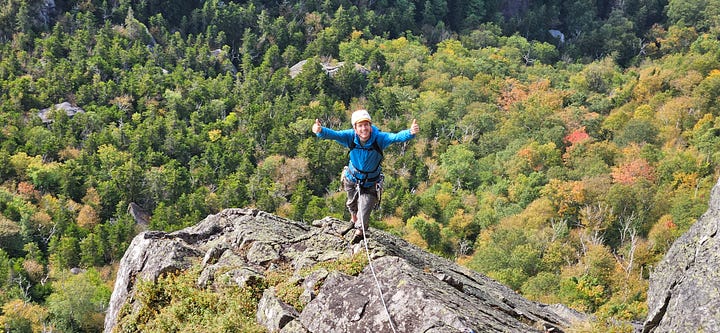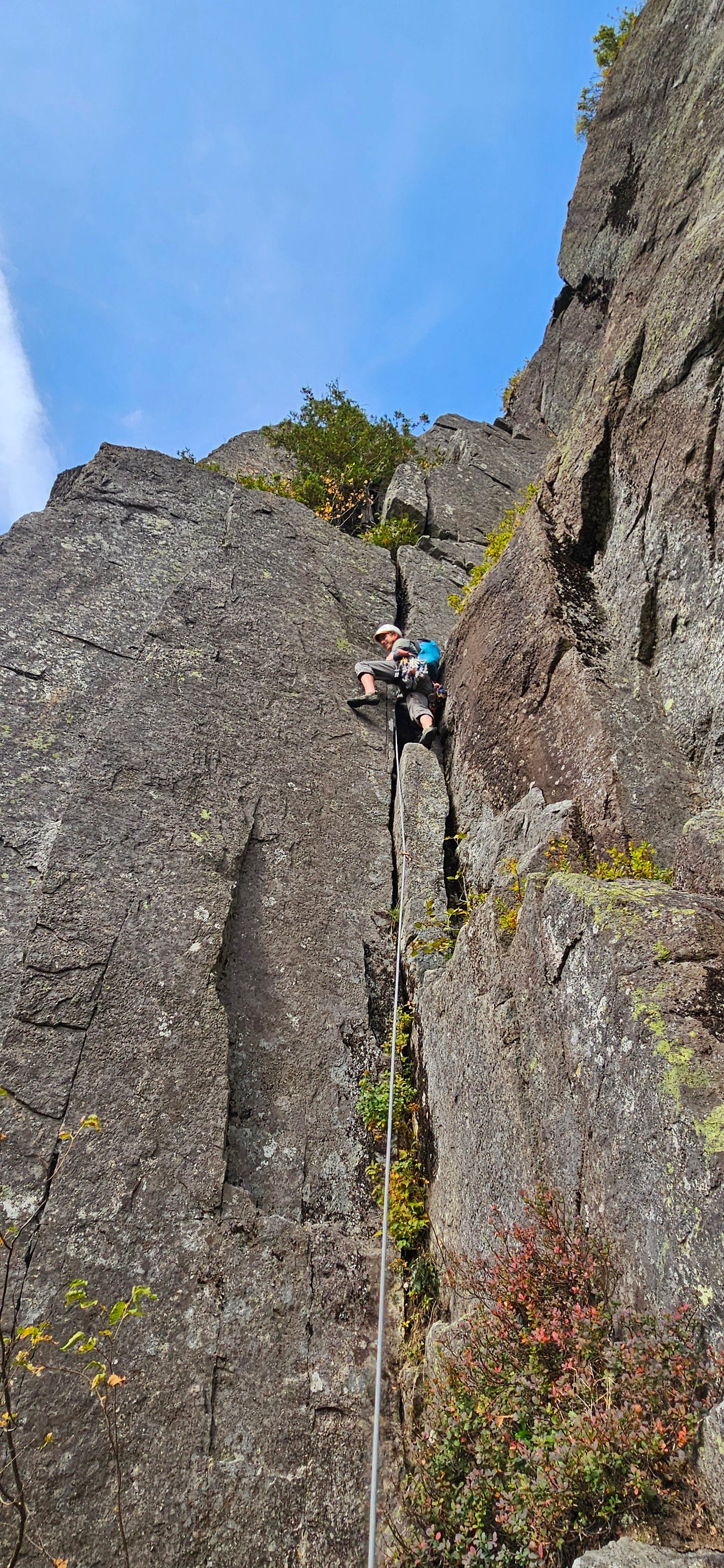Ed and Ted’s Excellent Adventure
A trip report about climbing the Diagonal (5.8) on Wallface Mountain
When a rock climber moves to a new place, they inevitably want to explore the nearby rock. They must experience the nearby crags with their own two hands and feet. So, as a recent transplant to upstate New York, I was excited to see what the state had to offer. Besides the Gunks, I was most intrigued to check out the Adirondacks.
The Adirondack Park
The Adirondack Park (also known as the Dacks) in upstate New York is chock full of climbable rock. Some cliffs are small and far-flung. Last season, I went on a 10+ mile march in the pouring rain to do some recon on a cliff. Why? A friend of mine wanted to check it out and develop a new climb.
Other climbing areas in the Dacks are larger and more accessible. For example, the crags in Chapel Pond Pass. Most of these zones are roadside. You can even see climbers up on the walls if you know where to cast your gaze as you drive by.
Due to the geological age of the Dacks, most cliffs are not that tall. Typically, the older a mountain range is, the smaller the peaks. That’s why younger mountain ranges, like in the Himalayas, have such gigantic mountains. So, I would say the majority of the climbing in the Dacks is single-pitch. Even on taller cliffs, like Poke-O-Moonshine Mountain, the multi-pitches are only three or four pitches in length.
But, if you go deep enough into the High Peaks region of the Dacks, you start getting into larger mountains, like Mount Colden. And with larger mountains come larger rock walls, like Wallface.
Wallface Comes with Baggage
Wallface is located on the southeastern flank of Wallface Mountain. It gets its name from its most prominent feature, an 800-foot rock wall. The wall boasts many classic multi-pitch rock climbs. During the winter, ice climbers come to Wallface to sample its frozen flows of waterfall ice.
But, if you want to climb on Wallface, you have to be ready to endure its baggage. Wallface is far away. It is located about five miles deep in the Adirondack wilderness. To access the wall, you hike along the Indian Pass trail. According to one of the local guidebook authors, Jeremy Haas, the Indian Pass trail is one the least maintained trails in the Dacks.
Due to Wallface’s location and strenuous trail, it’s notorious for serving up some serious beatdowns. In my preparation for the climb, I read about five-hour epic hikes (that’s only one way!). I also read about horrendous trail conditions, like muddy bogs that swallow your feet up to your calves. And, of course, I read a multitude of horror stories about black fly infestations, for which the Adirondacks are notorious. If you’re from this part of the world, then you know how bad they can be.
Despite all that, I still wanted to go. That’s because last year, I could not line up a partner with a reliable weather window. (Or was it that I couldn’t find a partner who wanted to willingly subject themselves to the suffer-fest). Thus, climbing on Wallface became a goal I wanted to accomplish this year.
Fortunately for me, things lined up last month. Weather-wise, the Adirondacks had been dry the past couple of weeks, and the weekly forecast called for sunshine. Partner-wise, I linked together with a fellow co-guide named Ed. Ed and Ted. Like two peas in a pod.
The Diagonal (5.8)
It was first climbed in 1962 by Tom Rutledge and Jane Morgan. At the time, it was believed to be the longest rock climb in the Dacks. That is still true to this day. It may be one of the longest in the entire Northeast.
The route starts toward the southern end of the cliff. The route is characterized by three main sections– adventure climbing down low, slab climbing in the middle, and steep corner climbing at the top. It gets its name from the gigantic rightward angling diagonal ramp in the middle of the route.
To access the diagonal ramp, you take a journey through wondering terrain. As you romp your way up the easy lower pitches of the route, larger and steeper sections of the cliff begin to begin to creep up on your left. There are some seriously inspiring, harder, and old aid routes up there.
After a couple hundred feet, you gain access to the lowest section of the ramp. The ramp is slabby and low angle. It offers almost seemingly endless low-angle glory climbing. On your lefthand side, impressive buttresses loom over your head. On your right-hand side, the edge of the diagonal ramp dumps off into the abyss. It is safe to say that the position and exposure in this section of the route are phenomenal.


After navigating the ramp, you gain a wonderful ledge system. Back in the day, when a route like the Diagonal was too crazy of an endeavor to do in a single day, climbers would bivy overnight on this ledge. Nowadays, the ledge is the perfect spot to sunbathe and eat lunch. Above the ledge, the business starts.
One of the favorite characteristics of the Diagonal Route is that the harder crux climbing comes at the top. You get to settle into the route and enjoy some warm-up climbing before getting ready for the upper pitches.
After the ledge at the top of the ramp, several striking and steep corner systems shoot upwards. Before getting into the Diagonal’s headwall, you have to navigate a short finger crack that leads into an interesting chimney. After the short-lived chimney climbing, you’re positioned perfectly below the final crux corner.
At this point, it was technically Ed’s turn to lead, but he offered me the sharp end instead. That was generous. So I cast off and enjoyed a long pitch of technical corner climbing. Eventually, the corner gave way to the top of the Wallface cliff.
The view from the top was fantastic! Nearby, High Peaks surrounded us. I tried to locate Mt. Colden where Whitney and I climbed the Trap Dike earlier in the summer, but we were a little too far. Off in the distance, a cloud inversion settled into a valley. The tips of the mountains poked through the inversion like islands floating in the sky. 800 feet down below, the early autumn foliage decorated the valley floor with hues of red, orange, and yellow.
Debriefing the Diagonal
Overall, Ed and I had a great day out. We enjoyed relatively dry trail conditions and good weather. We were the first party on route, which was a bonus. The whole adventure took us about nine hours from car to car. That included about 800 feet of rock climbing and nine miles of hiking.
Although not technically located in an alpine environment, Wallface offers an alpine-like experience. There’s a lot of hiking, which takes time. Ed and I were walking by 4:30 am. Alternatively, you could hike out the day prior and spend the night near the base of the cliff. We found a sweet little spot that could offer an excellent camping experience.
Throughout that hike, there’s quite a bit of trail finding due to the trail’s dilapidated character (a major bridge is defunk, requiring you to rock hop over the river instead). Then, after the flat portion of the trail, the hiking trail sends it up a steep boulder field. But once you’re back there, enjoying the solitude and scenery and deploying your climbing skills, all the extra stuff adds to the value of the overall climbing experience.
Not to mention the climbing was great! It was very adventurous and well-protected. And although the cruxes clocked in at 5.8, I found them “soft” for the grade. Plus, the rock quality was quite good (there were a few loose things, but that’s to be expected on a big route like the Diagonal).
Looking back, I’m really glad I finally got the experience of doing a route on Wallface. Would I recommend it to other climbers? Absolutely. But you have to be ready for a little more than just climbing.







I could could climb into a few Dacky bars up there. Great read. Cant wait until personal drones can get you to the spot. I could get some great imagery of you fella. All the best. Dont forget to tell the readers the age and type of rock it it is. It's all out there.
Your passion for climbing is infectious. While I don't understand a lot of the terms, your descriptions of rock climbing make great metaphors for approaching life--practice, care, collaboration, persistence, and appreciation.